Capstone Project: Workplace Performance and Cognitive Artifacts Impact
VerifiedAdded on 2021/04/20
|57
|11223
|668
Capstone Project
AI Summary
This capstone project investigates the impact of cognitive artifacts on employee performance within the oil and gas sector, specifically focusing on KBR. The research explores the relationship between cognitive tools, such as task lists and project frameworks, and employee effectiveness. Employing a mixed-methods approach, the study analyzes both quantitative data from a survey of 100 employees and 3 managers, and qualitative data from interviews. The project examines the influence of cognitive artifacts on factors such as improved performance, innovative strategies, and effective outcomes. The analysis includes regression analysis to determine the correlation between cognitive artifacts and employee performance, with findings presented through tables, charts, and a conceptual framework. The capstone concludes with recommendations for enhancing cognitive artifacts to improve workplace performance, supported by a thorough literature review and a self-reflection component.
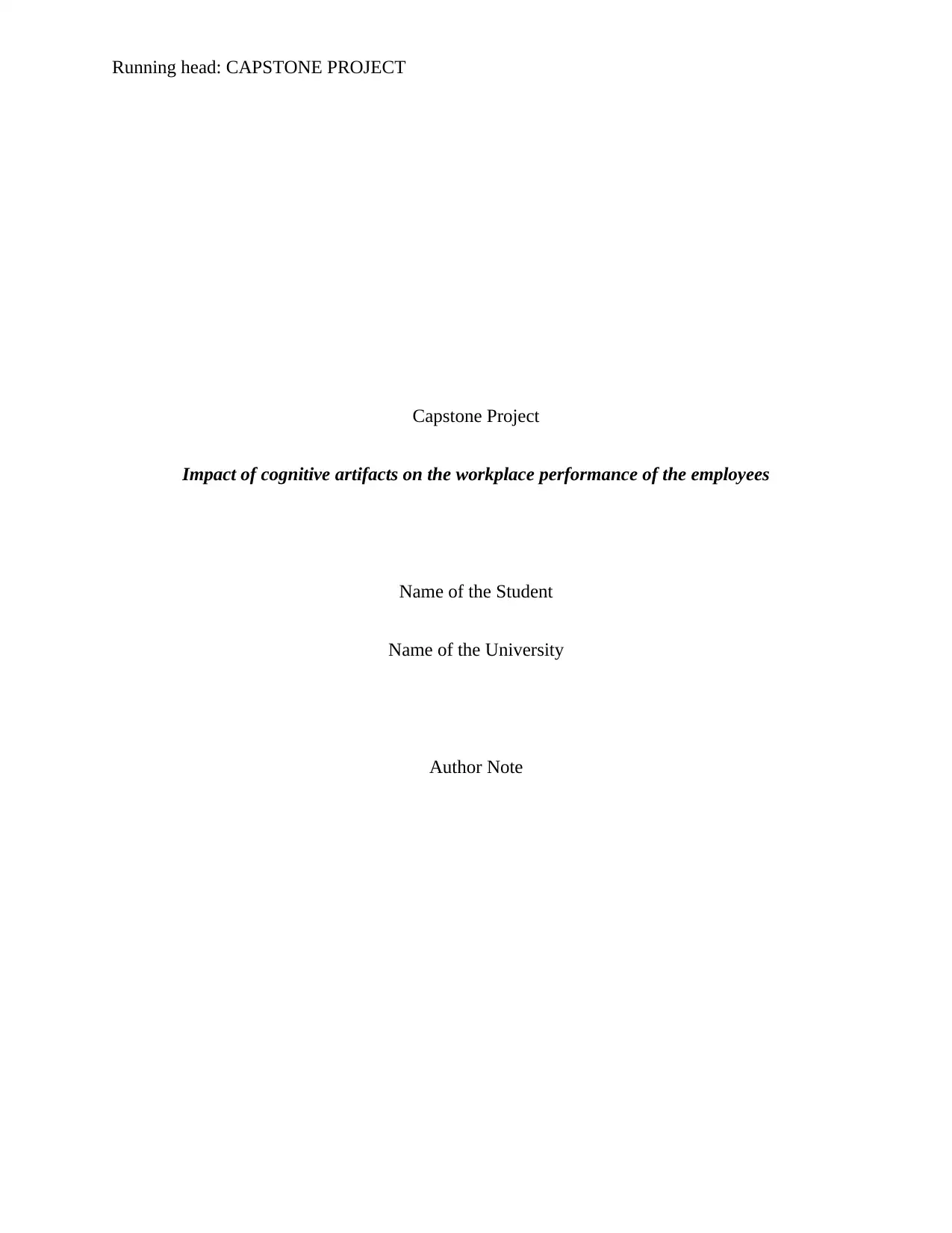
Running head: CAPSTONE PROJECT
Capstone Project
Impact of cognitive artifacts on the workplace performance of the employees
Name of the Student
Name of the University
Author Note
Capstone Project
Impact of cognitive artifacts on the workplace performance of the employees
Name of the Student
Name of the University
Author Note
Paraphrase This Document
Need a fresh take? Get an instant paraphrase of this document with our AI Paraphraser
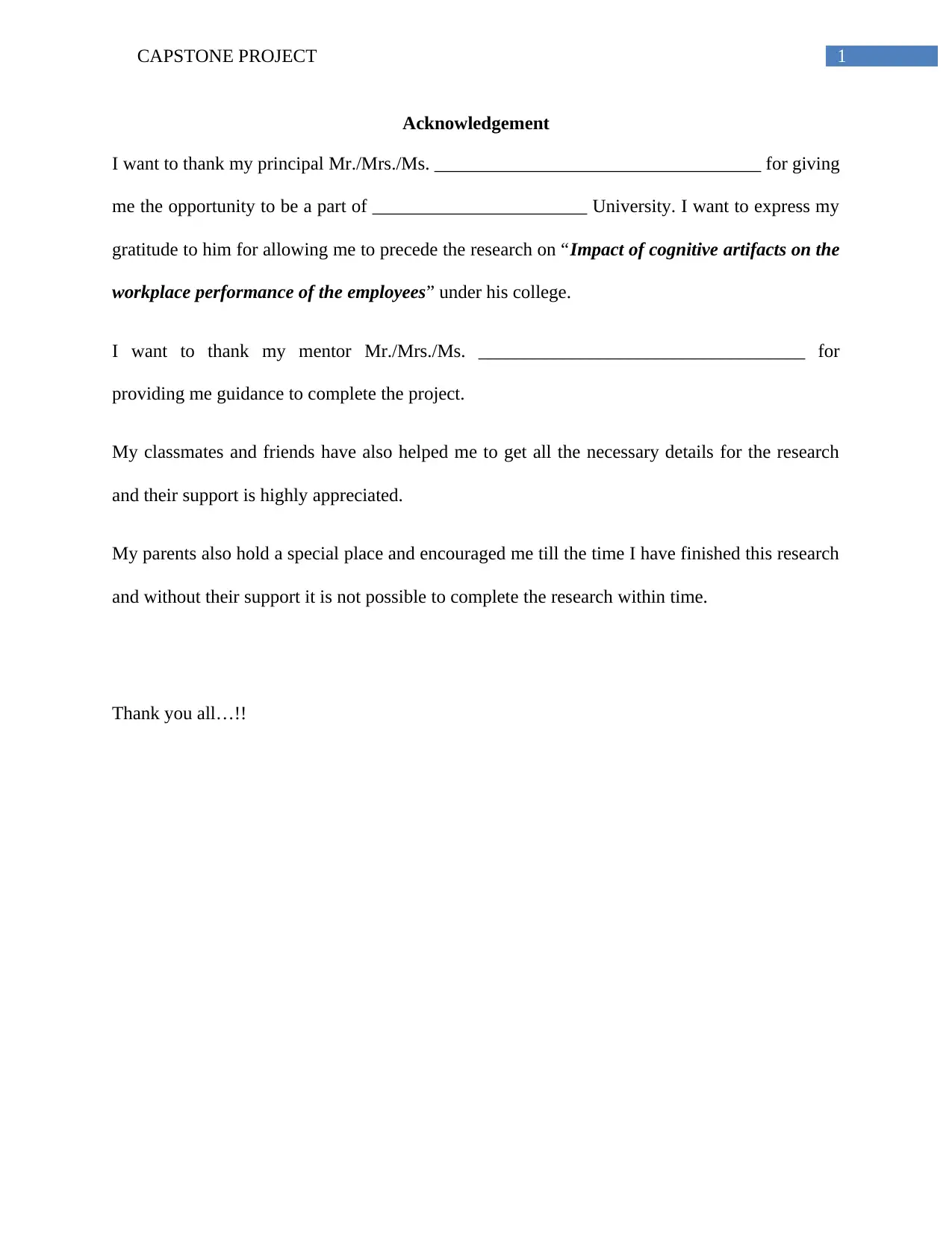
1CAPSTONE PROJECT
Acknowledgement
I want to thank my principal Mr./Mrs./Ms. ___________________________________ for giving
me the opportunity to be a part of _______________________ University. I want to express my
gratitude to him for allowing me to precede the research on “Impact of cognitive artifacts on the
workplace performance of the employees” under his college.
I want to thank my mentor Mr./Mrs./Ms. ___________________________________ for
providing me guidance to complete the project.
My classmates and friends have also helped me to get all the necessary details for the research
and their support is highly appreciated.
My parents also hold a special place and encouraged me till the time I have finished this research
and without their support it is not possible to complete the research within time.
Thank you all…!!
Acknowledgement
I want to thank my principal Mr./Mrs./Ms. ___________________________________ for giving
me the opportunity to be a part of _______________________ University. I want to express my
gratitude to him for allowing me to precede the research on “Impact of cognitive artifacts on the
workplace performance of the employees” under his college.
I want to thank my mentor Mr./Mrs./Ms. ___________________________________ for
providing me guidance to complete the project.
My classmates and friends have also helped me to get all the necessary details for the research
and their support is highly appreciated.
My parents also hold a special place and encouraged me till the time I have finished this research
and without their support it is not possible to complete the research within time.
Thank you all…!!
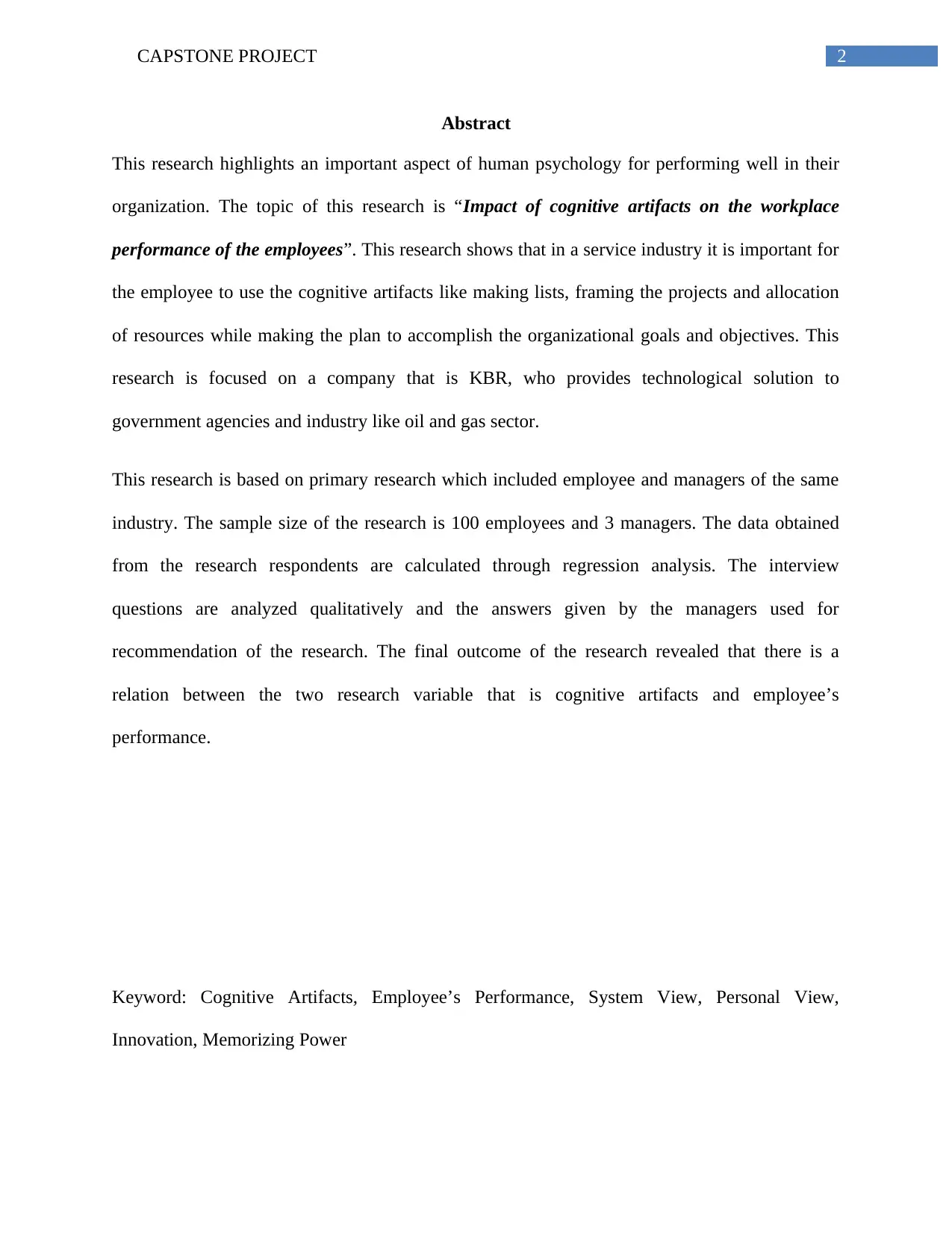
2CAPSTONE PROJECT
Abstract
This research highlights an important aspect of human psychology for performing well in their
organization. The topic of this research is “Impact of cognitive artifacts on the workplace
performance of the employees”. This research shows that in a service industry it is important for
the employee to use the cognitive artifacts like making lists, framing the projects and allocation
of resources while making the plan to accomplish the organizational goals and objectives. This
research is focused on a company that is KBR, who provides technological solution to
government agencies and industry like oil and gas sector.
This research is based on primary research which included employee and managers of the same
industry. The sample size of the research is 100 employees and 3 managers. The data obtained
from the research respondents are calculated through regression analysis. The interview
questions are analyzed qualitatively and the answers given by the managers used for
recommendation of the research. The final outcome of the research revealed that there is a
relation between the two research variable that is cognitive artifacts and employee’s
performance.
Keyword: Cognitive Artifacts, Employee’s Performance, System View, Personal View,
Innovation, Memorizing Power
Abstract
This research highlights an important aspect of human psychology for performing well in their
organization. The topic of this research is “Impact of cognitive artifacts on the workplace
performance of the employees”. This research shows that in a service industry it is important for
the employee to use the cognitive artifacts like making lists, framing the projects and allocation
of resources while making the plan to accomplish the organizational goals and objectives. This
research is focused on a company that is KBR, who provides technological solution to
government agencies and industry like oil and gas sector.
This research is based on primary research which included employee and managers of the same
industry. The sample size of the research is 100 employees and 3 managers. The data obtained
from the research respondents are calculated through regression analysis. The interview
questions are analyzed qualitatively and the answers given by the managers used for
recommendation of the research. The final outcome of the research revealed that there is a
relation between the two research variable that is cognitive artifacts and employee’s
performance.
Keyword: Cognitive Artifacts, Employee’s Performance, System View, Personal View,
Innovation, Memorizing Power
⊘ This is a preview!⊘
Do you want full access?
Subscribe today to unlock all pages.

Trusted by 1+ million students worldwide
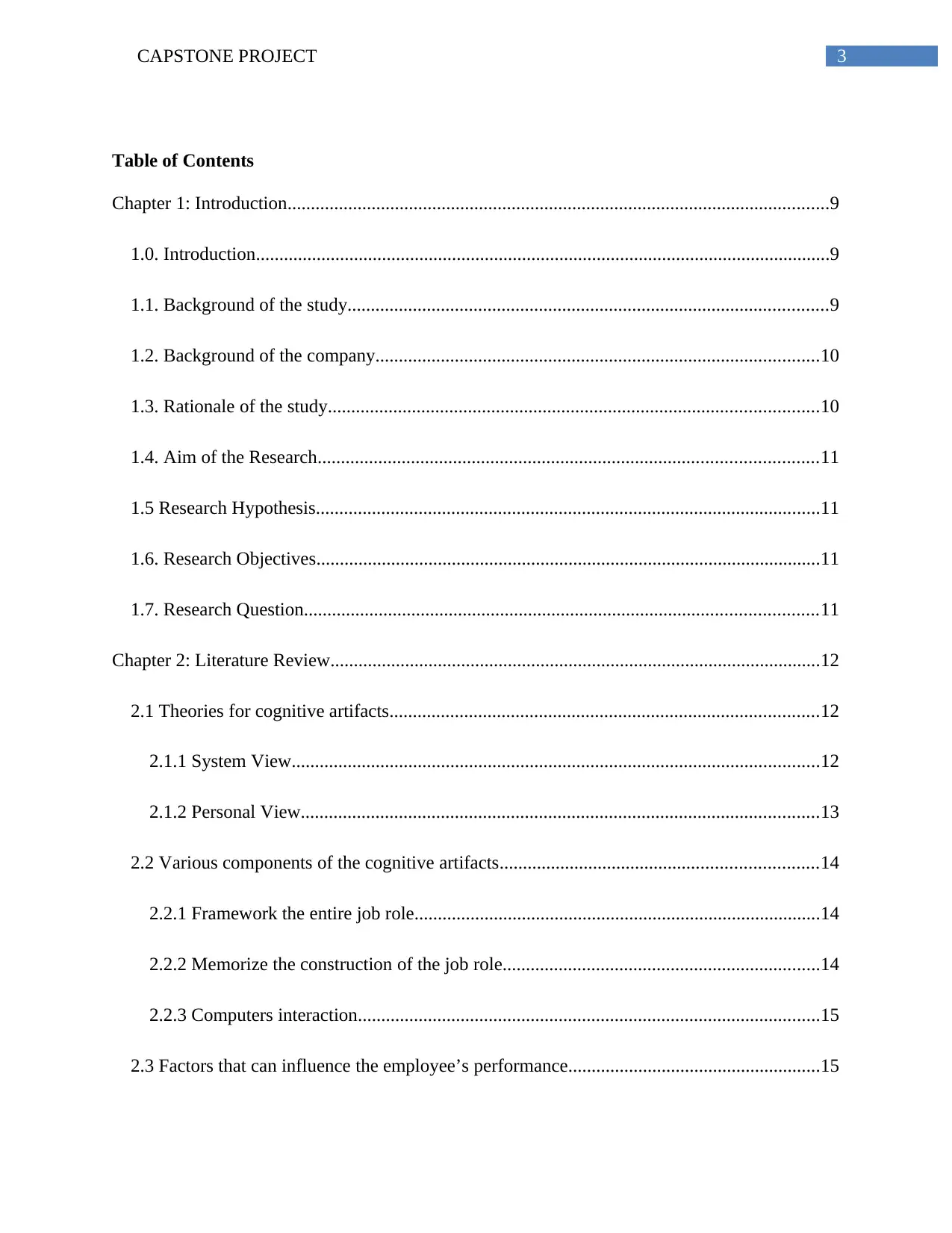
3CAPSTONE PROJECT
Table of Contents
Chapter 1: Introduction....................................................................................................................9
1.0. Introduction...........................................................................................................................9
1.1. Background of the study.......................................................................................................9
1.2. Background of the company...............................................................................................10
1.3. Rationale of the study.........................................................................................................10
1.4. Aim of the Research...........................................................................................................11
1.5 Research Hypothesis............................................................................................................11
1.6. Research Objectives............................................................................................................11
1.7. Research Question..............................................................................................................11
Chapter 2: Literature Review.........................................................................................................12
2.1 Theories for cognitive artifacts............................................................................................12
2.1.1 System View.................................................................................................................12
2.1.2 Personal View...............................................................................................................13
2.2 Various components of the cognitive artifacts....................................................................14
2.2.1 Framework the entire job role.......................................................................................14
2.2.2 Memorize the construction of the job role....................................................................14
2.2.3 Computers interaction...................................................................................................15
2.3 Factors that can influence the employee’s performance......................................................15
Table of Contents
Chapter 1: Introduction....................................................................................................................9
1.0. Introduction...........................................................................................................................9
1.1. Background of the study.......................................................................................................9
1.2. Background of the company...............................................................................................10
1.3. Rationale of the study.........................................................................................................10
1.4. Aim of the Research...........................................................................................................11
1.5 Research Hypothesis............................................................................................................11
1.6. Research Objectives............................................................................................................11
1.7. Research Question..............................................................................................................11
Chapter 2: Literature Review.........................................................................................................12
2.1 Theories for cognitive artifacts............................................................................................12
2.1.1 System View.................................................................................................................12
2.1.2 Personal View...............................................................................................................13
2.2 Various components of the cognitive artifacts....................................................................14
2.2.1 Framework the entire job role.......................................................................................14
2.2.2 Memorize the construction of the job role....................................................................14
2.2.3 Computers interaction...................................................................................................15
2.3 Factors that can influence the employee’s performance......................................................15
Paraphrase This Document
Need a fresh take? Get an instant paraphrase of this document with our AI Paraphraser
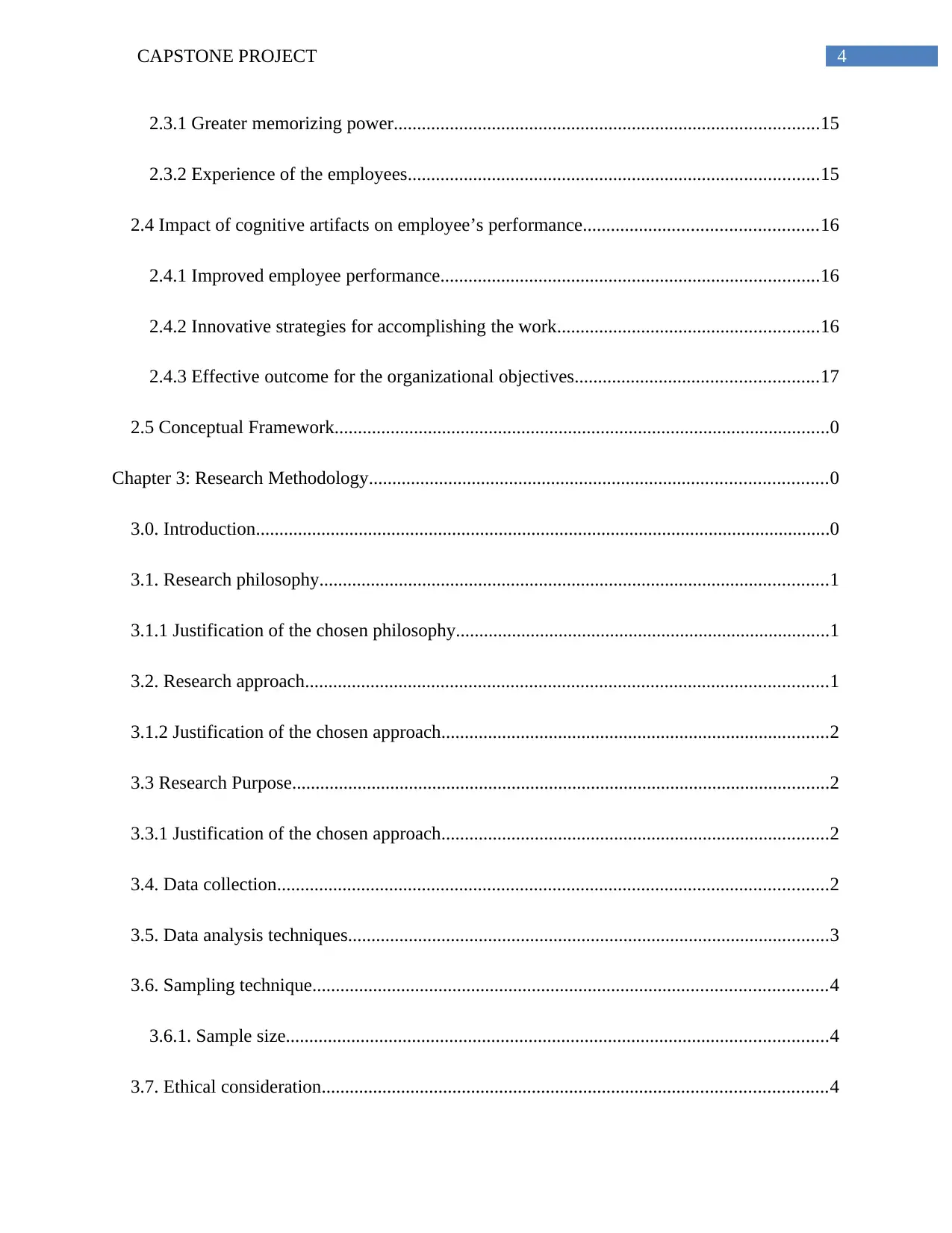
4CAPSTONE PROJECT
2.3.1 Greater memorizing power...........................................................................................15
2.3.2 Experience of the employees........................................................................................15
2.4 Impact of cognitive artifacts on employee’s performance..................................................16
2.4.1 Improved employee performance.................................................................................16
2.4.2 Innovative strategies for accomplishing the work........................................................16
2.4.3 Effective outcome for the organizational objectives....................................................17
2.5 Conceptual Framework..........................................................................................................0
Chapter 3: Research Methodology..................................................................................................0
3.0. Introduction...........................................................................................................................0
3.1. Research philosophy.............................................................................................................1
3.1.1 Justification of the chosen philosophy................................................................................1
3.2. Research approach................................................................................................................1
3.1.2 Justification of the chosen approach...................................................................................2
3.3 Research Purpose...................................................................................................................2
3.3.1 Justification of the chosen approach...................................................................................2
3.4. Data collection......................................................................................................................2
3.5. Data analysis techniques.......................................................................................................3
3.6. Sampling technique..............................................................................................................4
3.6.1. Sample size....................................................................................................................4
3.7. Ethical consideration............................................................................................................4
2.3.1 Greater memorizing power...........................................................................................15
2.3.2 Experience of the employees........................................................................................15
2.4 Impact of cognitive artifacts on employee’s performance..................................................16
2.4.1 Improved employee performance.................................................................................16
2.4.2 Innovative strategies for accomplishing the work........................................................16
2.4.3 Effective outcome for the organizational objectives....................................................17
2.5 Conceptual Framework..........................................................................................................0
Chapter 3: Research Methodology..................................................................................................0
3.0. Introduction...........................................................................................................................0
3.1. Research philosophy.............................................................................................................1
3.1.1 Justification of the chosen philosophy................................................................................1
3.2. Research approach................................................................................................................1
3.1.2 Justification of the chosen approach...................................................................................2
3.3 Research Purpose...................................................................................................................2
3.3.1 Justification of the chosen approach...................................................................................2
3.4. Data collection......................................................................................................................2
3.5. Data analysis techniques.......................................................................................................3
3.6. Sampling technique..............................................................................................................4
3.6.1. Sample size....................................................................................................................4
3.7. Ethical consideration............................................................................................................4
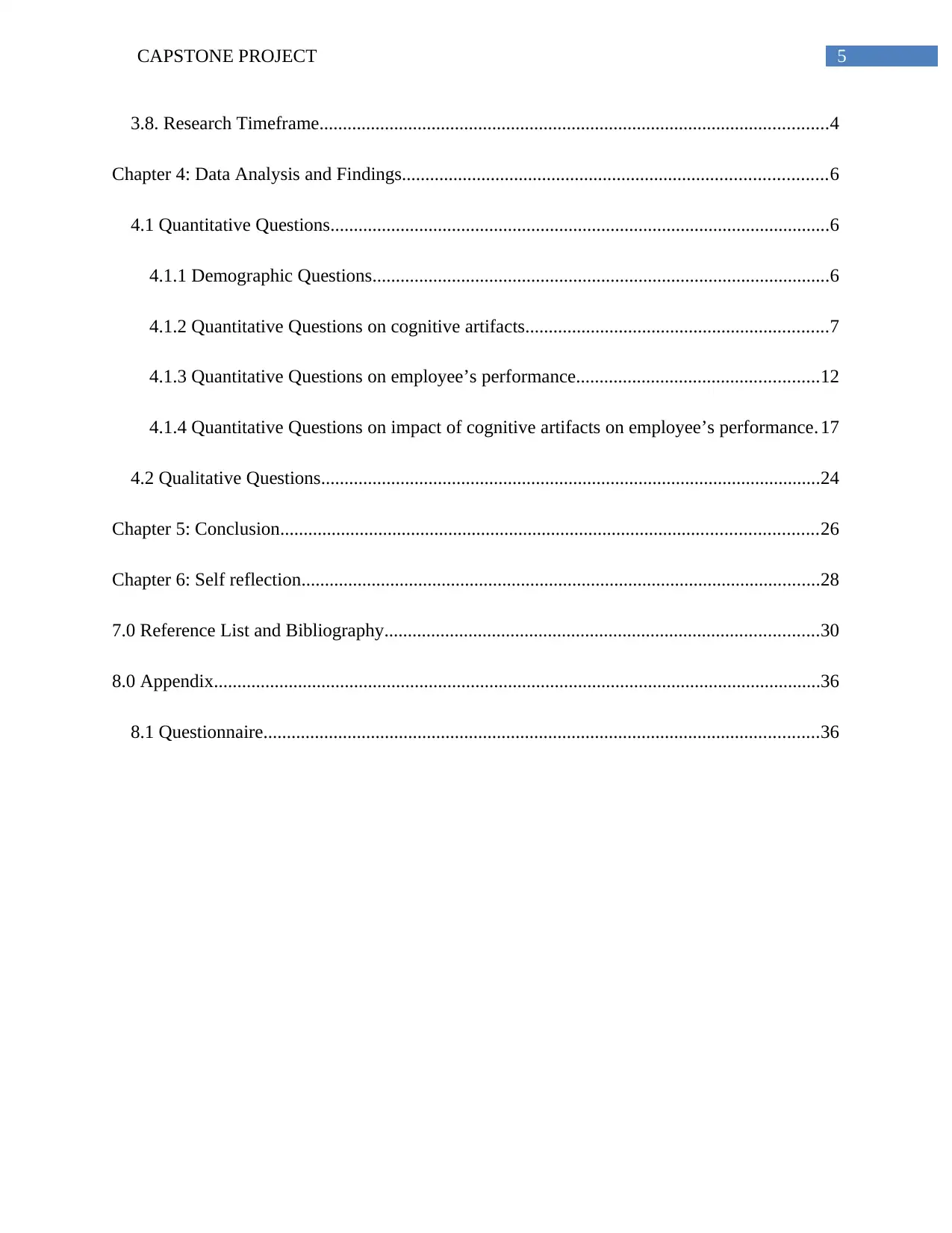
5CAPSTONE PROJECT
3.8. Research Timeframe.............................................................................................................4
Chapter 4: Data Analysis and Findings...........................................................................................6
4.1 Quantitative Questions...........................................................................................................6
4.1.1 Demographic Questions..................................................................................................6
4.1.2 Quantitative Questions on cognitive artifacts.................................................................7
4.1.3 Quantitative Questions on employee’s performance....................................................12
4.1.4 Quantitative Questions on impact of cognitive artifacts on employee’s performance. 17
4.2 Qualitative Questions...........................................................................................................24
Chapter 5: Conclusion...................................................................................................................26
Chapter 6: Self reflection...............................................................................................................28
7.0 Reference List and Bibliography.............................................................................................30
8.0 Appendix..................................................................................................................................36
8.1 Questionnaire.......................................................................................................................36
3.8. Research Timeframe.............................................................................................................4
Chapter 4: Data Analysis and Findings...........................................................................................6
4.1 Quantitative Questions...........................................................................................................6
4.1.1 Demographic Questions..................................................................................................6
4.1.2 Quantitative Questions on cognitive artifacts.................................................................7
4.1.3 Quantitative Questions on employee’s performance....................................................12
4.1.4 Quantitative Questions on impact of cognitive artifacts on employee’s performance. 17
4.2 Qualitative Questions...........................................................................................................24
Chapter 5: Conclusion...................................................................................................................26
Chapter 6: Self reflection...............................................................................................................28
7.0 Reference List and Bibliography.............................................................................................30
8.0 Appendix..................................................................................................................................36
8.1 Questionnaire.......................................................................................................................36
⊘ This is a preview!⊘
Do you want full access?
Subscribe today to unlock all pages.

Trusted by 1+ million students worldwide
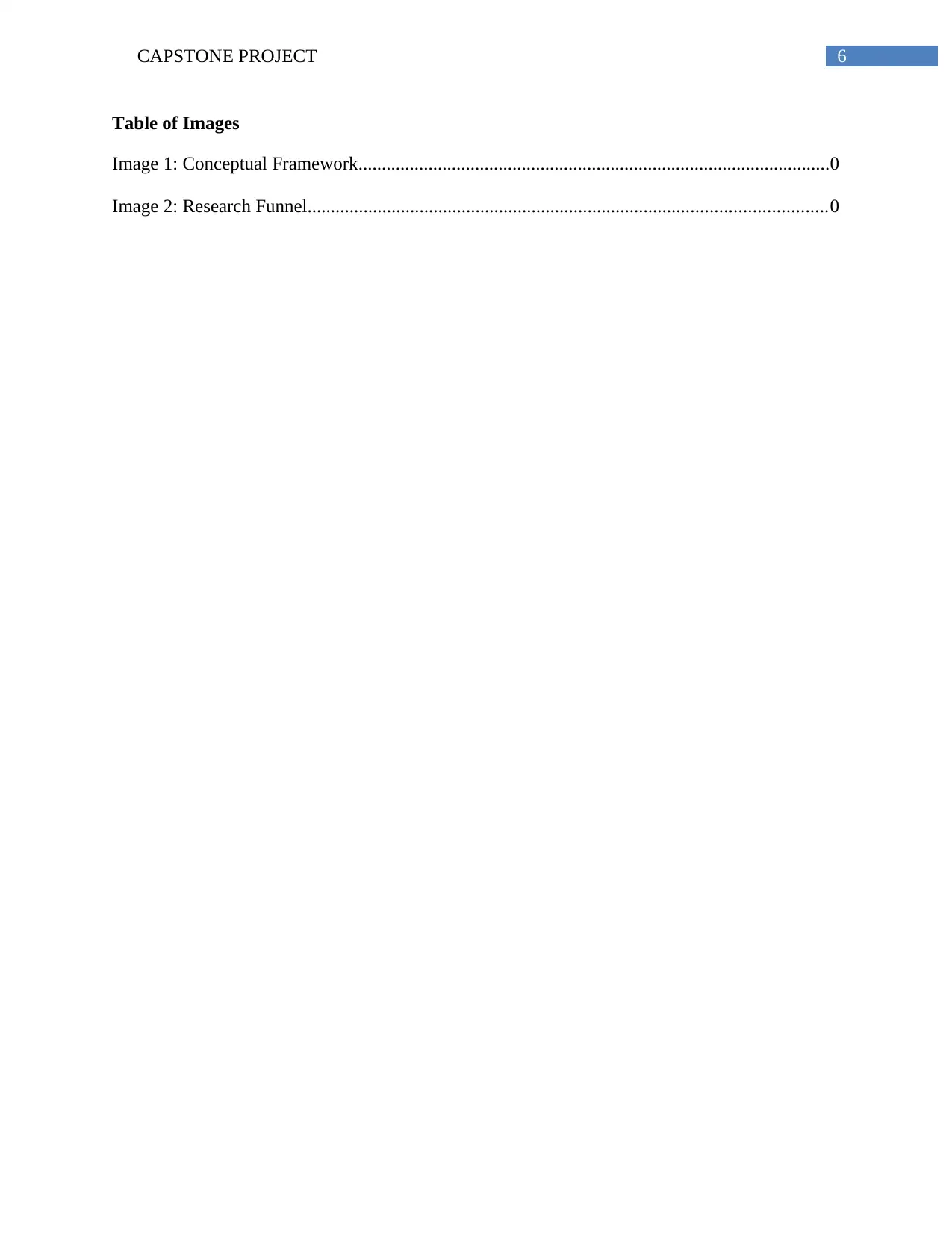
6CAPSTONE PROJECT
Table of Images
Image 1: Conceptual Framework.....................................................................................................0
Image 2: Research Funnel...............................................................................................................0
Table of Images
Image 1: Conceptual Framework.....................................................................................................0
Image 2: Research Funnel...............................................................................................................0
Paraphrase This Document
Need a fresh take? Get an instant paraphrase of this document with our AI Paraphraser
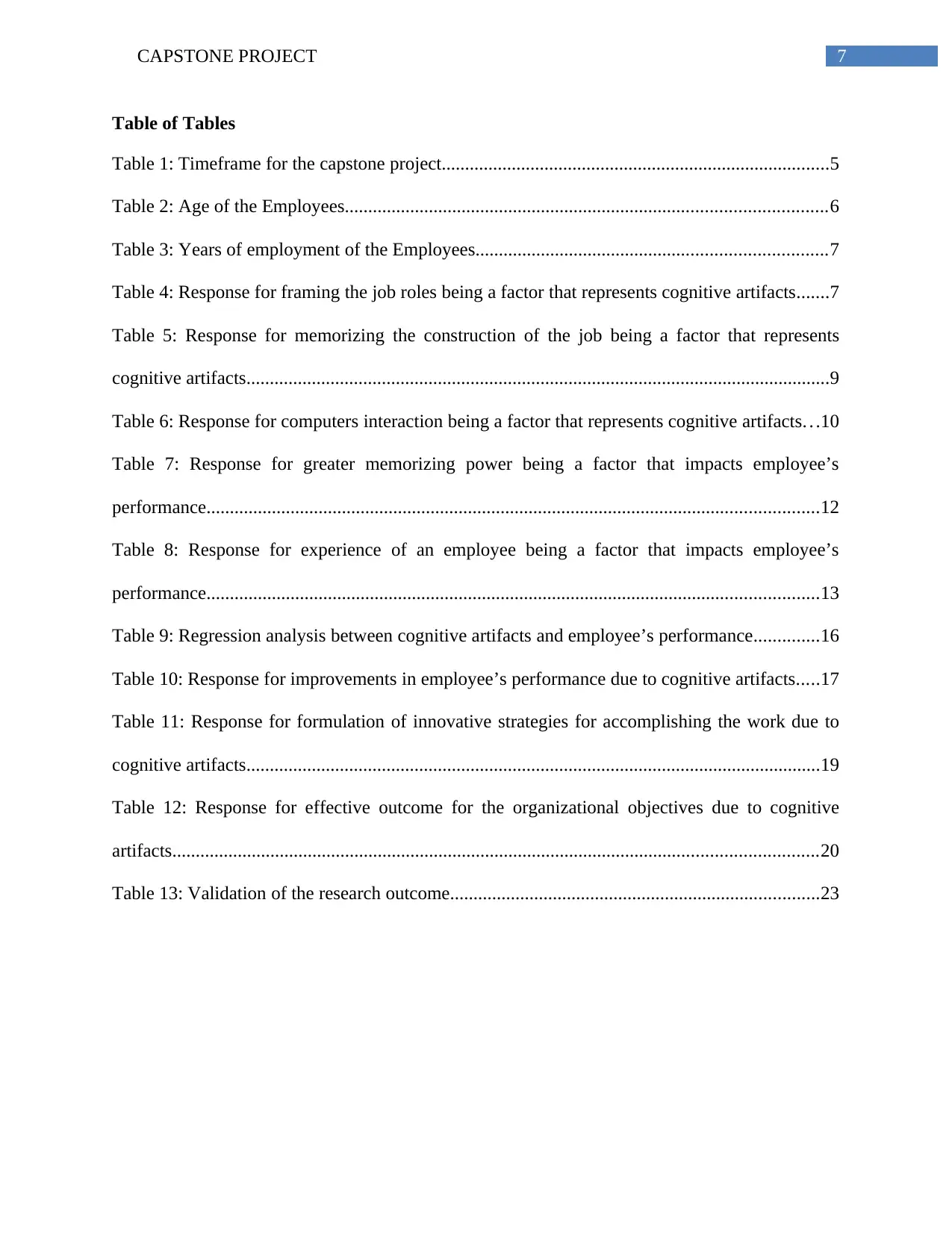
7CAPSTONE PROJECT
Table of Tables
Table 1: Timeframe for the capstone project...................................................................................5
Table 2: Age of the Employees.......................................................................................................6
Table 3: Years of employment of the Employees...........................................................................7
Table 4: Response for framing the job roles being a factor that represents cognitive artifacts.......7
Table 5: Response for memorizing the construction of the job being a factor that represents
cognitive artifacts.............................................................................................................................9
Table 6: Response for computers interaction being a factor that represents cognitive artifacts. . .10
Table 7: Response for greater memorizing power being a factor that impacts employee’s
performance...................................................................................................................................12
Table 8: Response for experience of an employee being a factor that impacts employee’s
performance...................................................................................................................................13
Table 9: Regression analysis between cognitive artifacts and employee’s performance..............16
Table 10: Response for improvements in employee’s performance due to cognitive artifacts.....17
Table 11: Response for formulation of innovative strategies for accomplishing the work due to
cognitive artifacts...........................................................................................................................19
Table 12: Response for effective outcome for the organizational objectives due to cognitive
artifacts..........................................................................................................................................20
Table 13: Validation of the research outcome...............................................................................23
Table of Tables
Table 1: Timeframe for the capstone project...................................................................................5
Table 2: Age of the Employees.......................................................................................................6
Table 3: Years of employment of the Employees...........................................................................7
Table 4: Response for framing the job roles being a factor that represents cognitive artifacts.......7
Table 5: Response for memorizing the construction of the job being a factor that represents
cognitive artifacts.............................................................................................................................9
Table 6: Response for computers interaction being a factor that represents cognitive artifacts. . .10
Table 7: Response for greater memorizing power being a factor that impacts employee’s
performance...................................................................................................................................12
Table 8: Response for experience of an employee being a factor that impacts employee’s
performance...................................................................................................................................13
Table 9: Regression analysis between cognitive artifacts and employee’s performance..............16
Table 10: Response for improvements in employee’s performance due to cognitive artifacts.....17
Table 11: Response for formulation of innovative strategies for accomplishing the work due to
cognitive artifacts...........................................................................................................................19
Table 12: Response for effective outcome for the organizational objectives due to cognitive
artifacts..........................................................................................................................................20
Table 13: Validation of the research outcome...............................................................................23
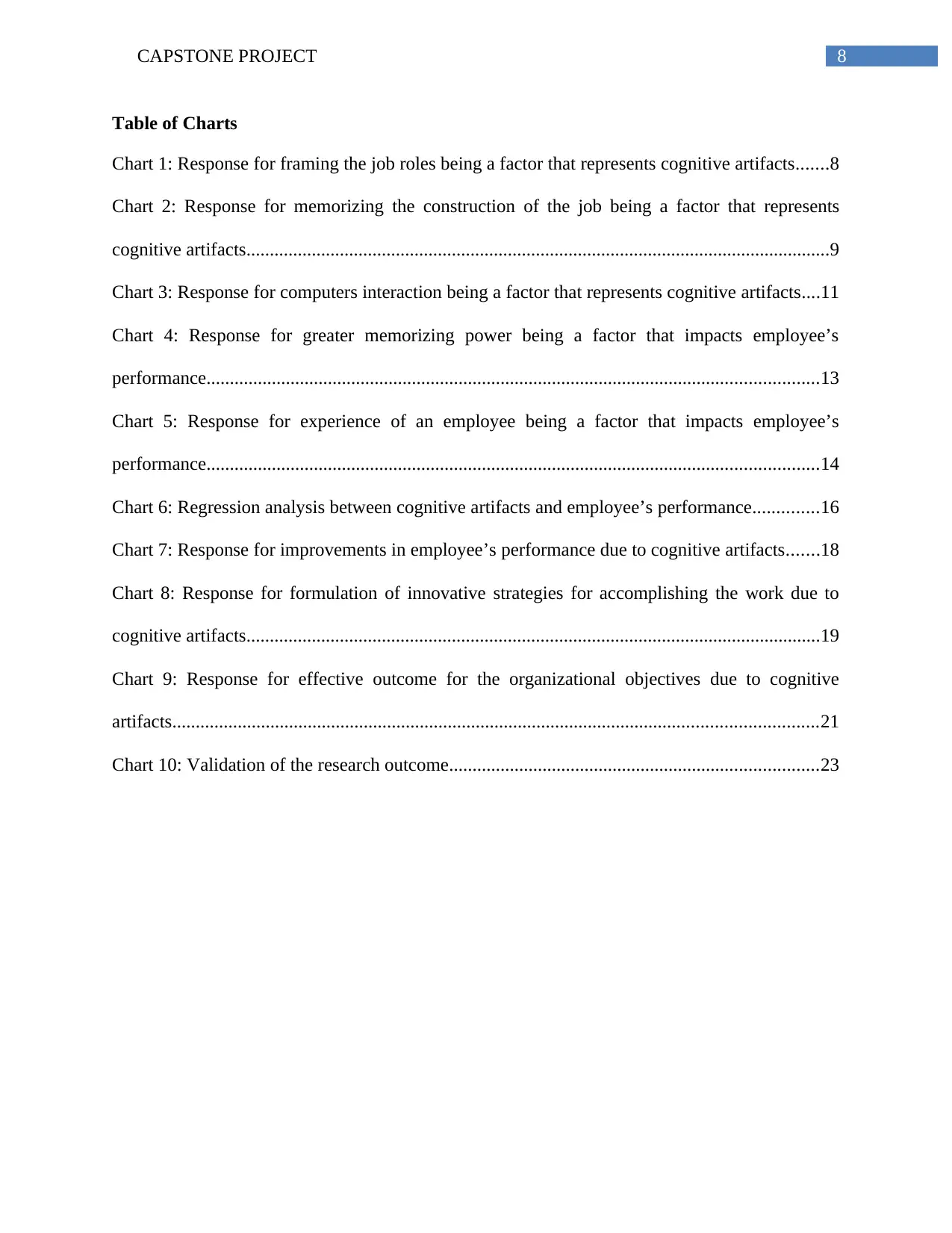
8CAPSTONE PROJECT
Table of Charts
Chart 1: Response for framing the job roles being a factor that represents cognitive artifacts.......8
Chart 2: Response for memorizing the construction of the job being a factor that represents
cognitive artifacts.............................................................................................................................9
Chart 3: Response for computers interaction being a factor that represents cognitive artifacts....11
Chart 4: Response for greater memorizing power being a factor that impacts employee’s
performance...................................................................................................................................13
Chart 5: Response for experience of an employee being a factor that impacts employee’s
performance...................................................................................................................................14
Chart 6: Regression analysis between cognitive artifacts and employee’s performance..............16
Chart 7: Response for improvements in employee’s performance due to cognitive artifacts.......18
Chart 8: Response for formulation of innovative strategies for accomplishing the work due to
cognitive artifacts...........................................................................................................................19
Chart 9: Response for effective outcome for the organizational objectives due to cognitive
artifacts..........................................................................................................................................21
Chart 10: Validation of the research outcome...............................................................................23
Table of Charts
Chart 1: Response for framing the job roles being a factor that represents cognitive artifacts.......8
Chart 2: Response for memorizing the construction of the job being a factor that represents
cognitive artifacts.............................................................................................................................9
Chart 3: Response for computers interaction being a factor that represents cognitive artifacts....11
Chart 4: Response for greater memorizing power being a factor that impacts employee’s
performance...................................................................................................................................13
Chart 5: Response for experience of an employee being a factor that impacts employee’s
performance...................................................................................................................................14
Chart 6: Regression analysis between cognitive artifacts and employee’s performance..............16
Chart 7: Response for improvements in employee’s performance due to cognitive artifacts.......18
Chart 8: Response for formulation of innovative strategies for accomplishing the work due to
cognitive artifacts...........................................................................................................................19
Chart 9: Response for effective outcome for the organizational objectives due to cognitive
artifacts..........................................................................................................................................21
Chart 10: Validation of the research outcome...............................................................................23
⊘ This is a preview!⊘
Do you want full access?
Subscribe today to unlock all pages.

Trusted by 1+ million students worldwide
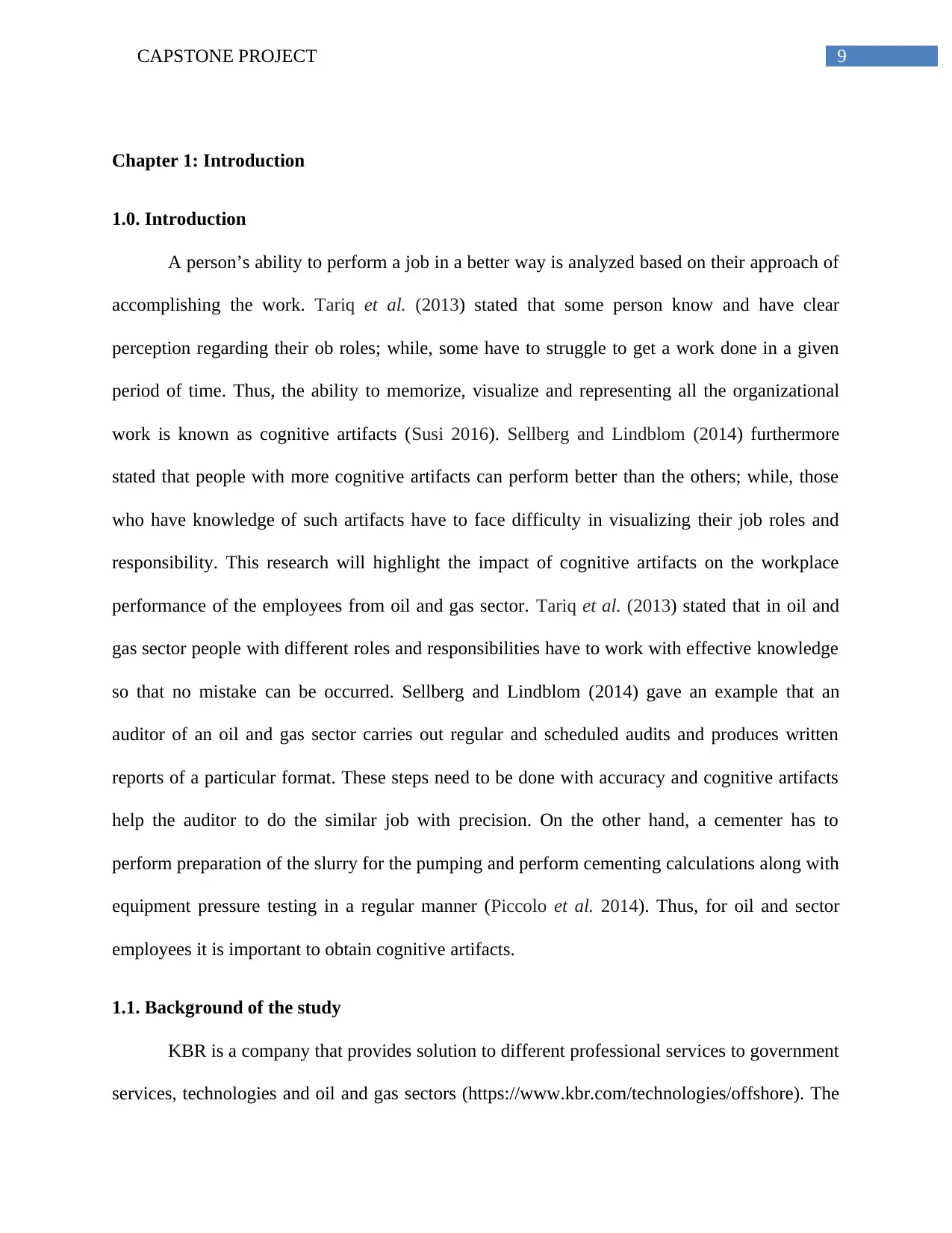
9CAPSTONE PROJECT
Chapter 1: Introduction
1.0. Introduction
A person’s ability to perform a job in a better way is analyzed based on their approach of
accomplishing the work. Tariq et al. (2013) stated that some person know and have clear
perception regarding their ob roles; while, some have to struggle to get a work done in a given
period of time. Thus, the ability to memorize, visualize and representing all the organizational
work is known as cognitive artifacts (Susi 2016). Sellberg and Lindblom (2014) furthermore
stated that people with more cognitive artifacts can perform better than the others; while, those
who have knowledge of such artifacts have to face difficulty in visualizing their job roles and
responsibility. This research will highlight the impact of cognitive artifacts on the workplace
performance of the employees from oil and gas sector. Tariq et al. (2013) stated that in oil and
gas sector people with different roles and responsibilities have to work with effective knowledge
so that no mistake can be occurred. Sellberg and Lindblom (2014) gave an example that an
auditor of an oil and gas sector carries out regular and scheduled audits and produces written
reports of a particular format. These steps need to be done with accuracy and cognitive artifacts
help the auditor to do the similar job with precision. On the other hand, a cementer has to
perform preparation of the slurry for the pumping and perform cementing calculations along with
equipment pressure testing in a regular manner (Piccolo et al. 2014). Thus, for oil and sector
employees it is important to obtain cognitive artifacts.
1.1. Background of the study
KBR is a company that provides solution to different professional services to government
services, technologies and oil and gas sectors (https://www.kbr.com/technologies/offshore). The
Chapter 1: Introduction
1.0. Introduction
A person’s ability to perform a job in a better way is analyzed based on their approach of
accomplishing the work. Tariq et al. (2013) stated that some person know and have clear
perception regarding their ob roles; while, some have to struggle to get a work done in a given
period of time. Thus, the ability to memorize, visualize and representing all the organizational
work is known as cognitive artifacts (Susi 2016). Sellberg and Lindblom (2014) furthermore
stated that people with more cognitive artifacts can perform better than the others; while, those
who have knowledge of such artifacts have to face difficulty in visualizing their job roles and
responsibility. This research will highlight the impact of cognitive artifacts on the workplace
performance of the employees from oil and gas sector. Tariq et al. (2013) stated that in oil and
gas sector people with different roles and responsibilities have to work with effective knowledge
so that no mistake can be occurred. Sellberg and Lindblom (2014) gave an example that an
auditor of an oil and gas sector carries out regular and scheduled audits and produces written
reports of a particular format. These steps need to be done with accuracy and cognitive artifacts
help the auditor to do the similar job with precision. On the other hand, a cementer has to
perform preparation of the slurry for the pumping and perform cementing calculations along with
equipment pressure testing in a regular manner (Piccolo et al. 2014). Thus, for oil and sector
employees it is important to obtain cognitive artifacts.
1.1. Background of the study
KBR is a company that provides solution to different professional services to government
services, technologies and oil and gas sectors (https://www.kbr.com/technologies/offshore). The
Paraphrase This Document
Need a fresh take? Get an instant paraphrase of this document with our AI Paraphraser
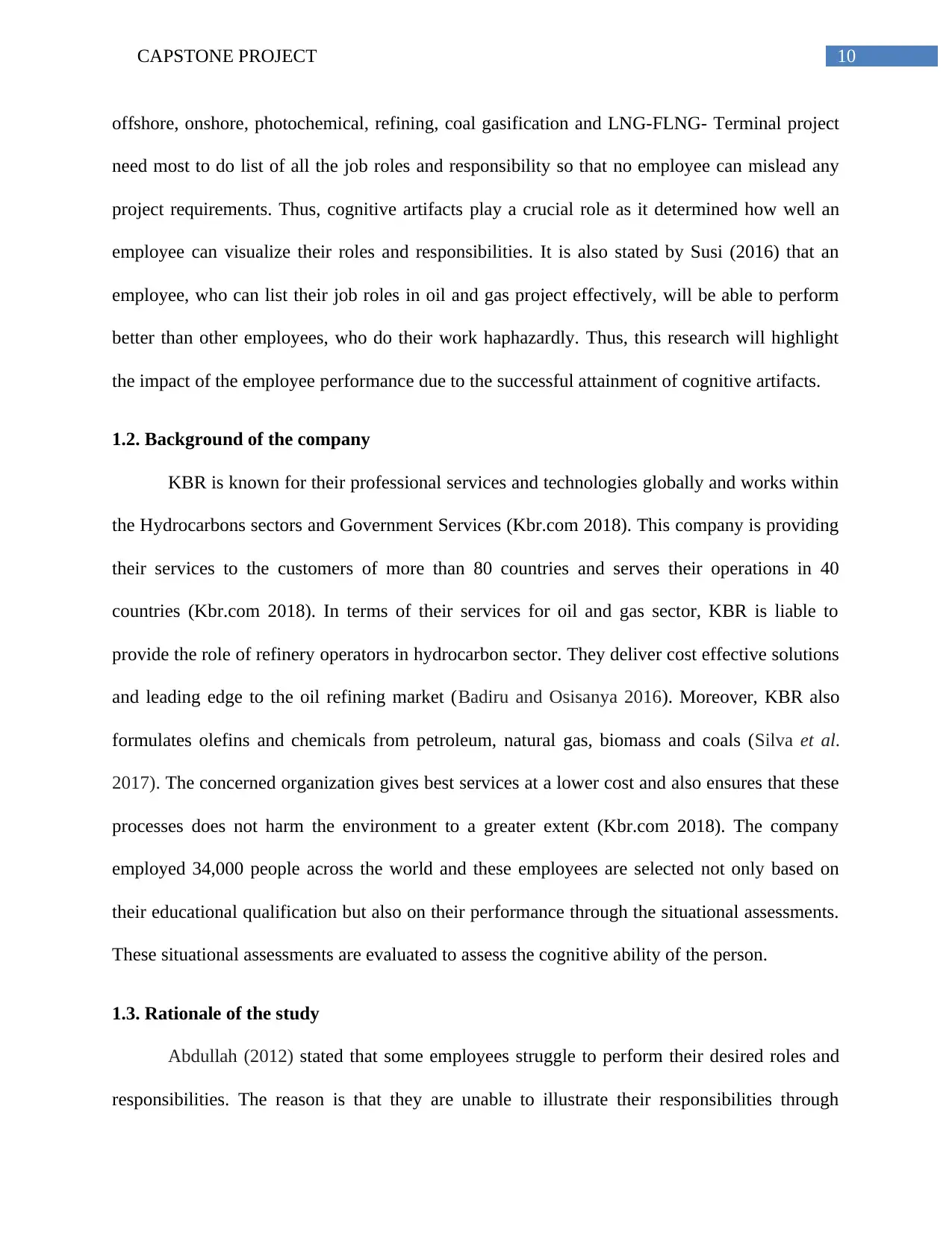
10CAPSTONE PROJECT
offshore, onshore, photochemical, refining, coal gasification and LNG-FLNG- Terminal project
need most to do list of all the job roles and responsibility so that no employee can mislead any
project requirements. Thus, cognitive artifacts play a crucial role as it determined how well an
employee can visualize their roles and responsibilities. It is also stated by Susi (2016) that an
employee, who can list their job roles in oil and gas project effectively, will be able to perform
better than other employees, who do their work haphazardly. Thus, this research will highlight
the impact of the employee performance due to the successful attainment of cognitive artifacts.
1.2. Background of the company
KBR is known for their professional services and technologies globally and works within
the Hydrocarbons sectors and Government Services (Kbr.com 2018). This company is providing
their services to the customers of more than 80 countries and serves their operations in 40
countries (Kbr.com 2018). In terms of their services for oil and gas sector, KBR is liable to
provide the role of refinery operators in hydrocarbon sector. They deliver cost effective solutions
and leading edge to the oil refining market (Badiru and Osisanya 2016). Moreover, KBR also
formulates olefins and chemicals from petroleum, natural gas, biomass and coals (Silva et al.
2017). The concerned organization gives best services at a lower cost and also ensures that these
processes does not harm the environment to a greater extent (Kbr.com 2018). The company
employed 34,000 people across the world and these employees are selected not only based on
their educational qualification but also on their performance through the situational assessments.
These situational assessments are evaluated to assess the cognitive ability of the person.
1.3. Rationale of the study
Abdullah (2012) stated that some employees struggle to perform their desired roles and
responsibilities. The reason is that they are unable to illustrate their responsibilities through
offshore, onshore, photochemical, refining, coal gasification and LNG-FLNG- Terminal project
need most to do list of all the job roles and responsibility so that no employee can mislead any
project requirements. Thus, cognitive artifacts play a crucial role as it determined how well an
employee can visualize their roles and responsibilities. It is also stated by Susi (2016) that an
employee, who can list their job roles in oil and gas project effectively, will be able to perform
better than other employees, who do their work haphazardly. Thus, this research will highlight
the impact of the employee performance due to the successful attainment of cognitive artifacts.
1.2. Background of the company
KBR is known for their professional services and technologies globally and works within
the Hydrocarbons sectors and Government Services (Kbr.com 2018). This company is providing
their services to the customers of more than 80 countries and serves their operations in 40
countries (Kbr.com 2018). In terms of their services for oil and gas sector, KBR is liable to
provide the role of refinery operators in hydrocarbon sector. They deliver cost effective solutions
and leading edge to the oil refining market (Badiru and Osisanya 2016). Moreover, KBR also
formulates olefins and chemicals from petroleum, natural gas, biomass and coals (Silva et al.
2017). The concerned organization gives best services at a lower cost and also ensures that these
processes does not harm the environment to a greater extent (Kbr.com 2018). The company
employed 34,000 people across the world and these employees are selected not only based on
their educational qualification but also on their performance through the situational assessments.
These situational assessments are evaluated to assess the cognitive ability of the person.
1.3. Rationale of the study
Abdullah (2012) stated that some employees struggle to perform their desired roles and
responsibilities. The reason is that they are unable to illustrate their responsibilities through
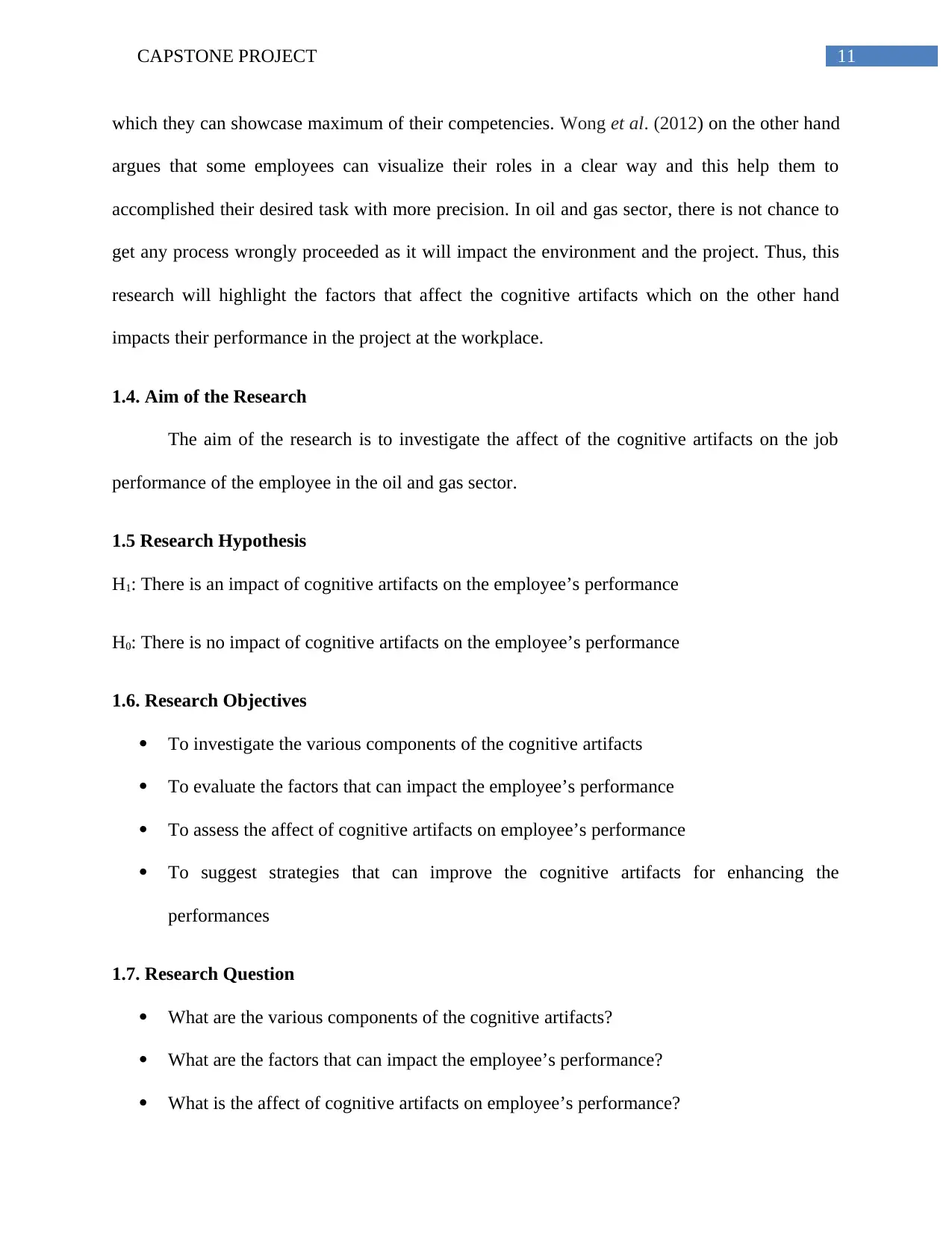
11CAPSTONE PROJECT
which they can showcase maximum of their competencies. Wong et al. (2012) on the other hand
argues that some employees can visualize their roles in a clear way and this help them to
accomplished their desired task with more precision. In oil and gas sector, there is not chance to
get any process wrongly proceeded as it will impact the environment and the project. Thus, this
research will highlight the factors that affect the cognitive artifacts which on the other hand
impacts their performance in the project at the workplace.
1.4. Aim of the Research
The aim of the research is to investigate the affect of the cognitive artifacts on the job
performance of the employee in the oil and gas sector.
1.5 Research Hypothesis
H1: There is an impact of cognitive artifacts on the employee’s performance
H0: There is no impact of cognitive artifacts on the employee’s performance
1.6. Research Objectives
To investigate the various components of the cognitive artifacts
To evaluate the factors that can impact the employee’s performance
To assess the affect of cognitive artifacts on employee’s performance
To suggest strategies that can improve the cognitive artifacts for enhancing the
performances
1.7. Research Question
What are the various components of the cognitive artifacts?
What are the factors that can impact the employee’s performance?
What is the affect of cognitive artifacts on employee’s performance?
which they can showcase maximum of their competencies. Wong et al. (2012) on the other hand
argues that some employees can visualize their roles in a clear way and this help them to
accomplished their desired task with more precision. In oil and gas sector, there is not chance to
get any process wrongly proceeded as it will impact the environment and the project. Thus, this
research will highlight the factors that affect the cognitive artifacts which on the other hand
impacts their performance in the project at the workplace.
1.4. Aim of the Research
The aim of the research is to investigate the affect of the cognitive artifacts on the job
performance of the employee in the oil and gas sector.
1.5 Research Hypothesis
H1: There is an impact of cognitive artifacts on the employee’s performance
H0: There is no impact of cognitive artifacts on the employee’s performance
1.6. Research Objectives
To investigate the various components of the cognitive artifacts
To evaluate the factors that can impact the employee’s performance
To assess the affect of cognitive artifacts on employee’s performance
To suggest strategies that can improve the cognitive artifacts for enhancing the
performances
1.7. Research Question
What are the various components of the cognitive artifacts?
What are the factors that can impact the employee’s performance?
What is the affect of cognitive artifacts on employee’s performance?
⊘ This is a preview!⊘
Do you want full access?
Subscribe today to unlock all pages.

Trusted by 1+ million students worldwide
1 out of 57
Related Documents
Your All-in-One AI-Powered Toolkit for Academic Success.
+13062052269
info@desklib.com
Available 24*7 on WhatsApp / Email
![[object Object]](/_next/static/media/star-bottom.7253800d.svg)
Unlock your academic potential
Copyright © 2020–2025 A2Z Services. All Rights Reserved. Developed and managed by ZUCOL.





